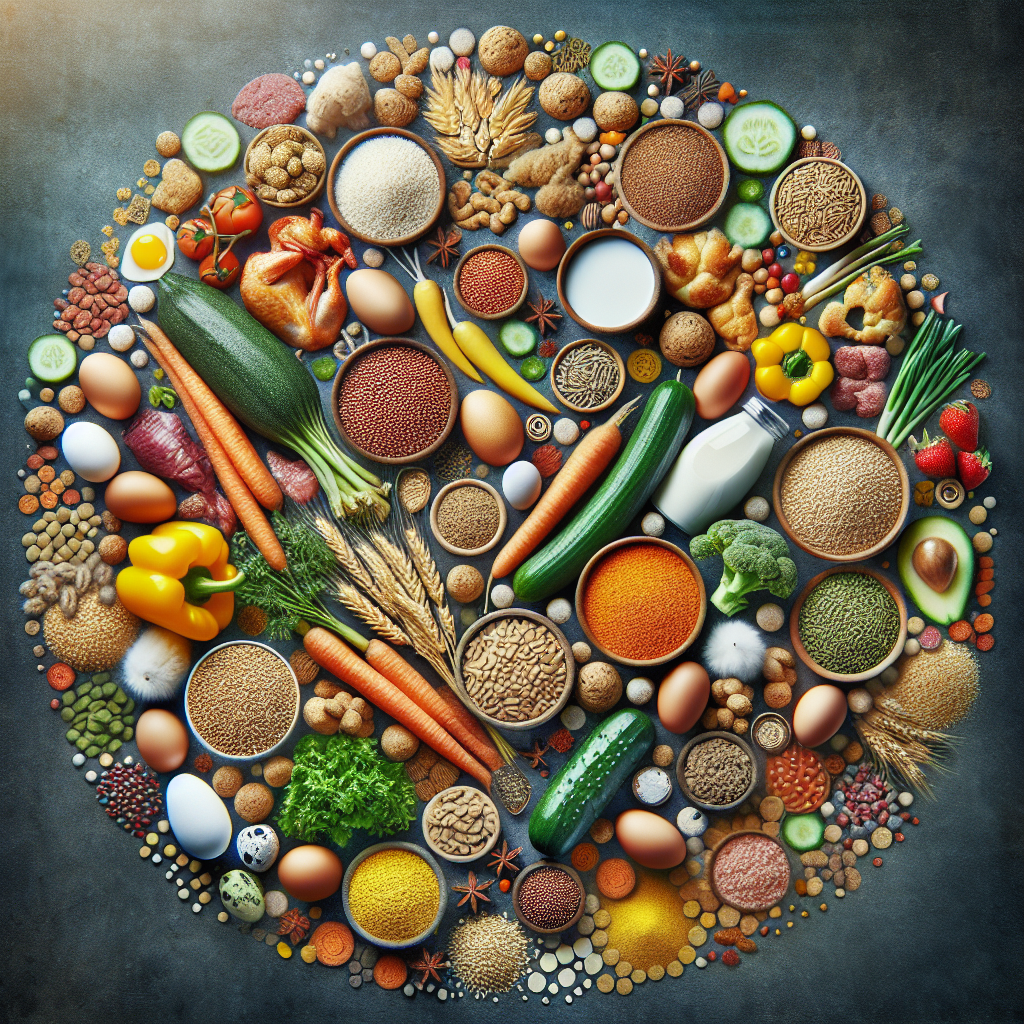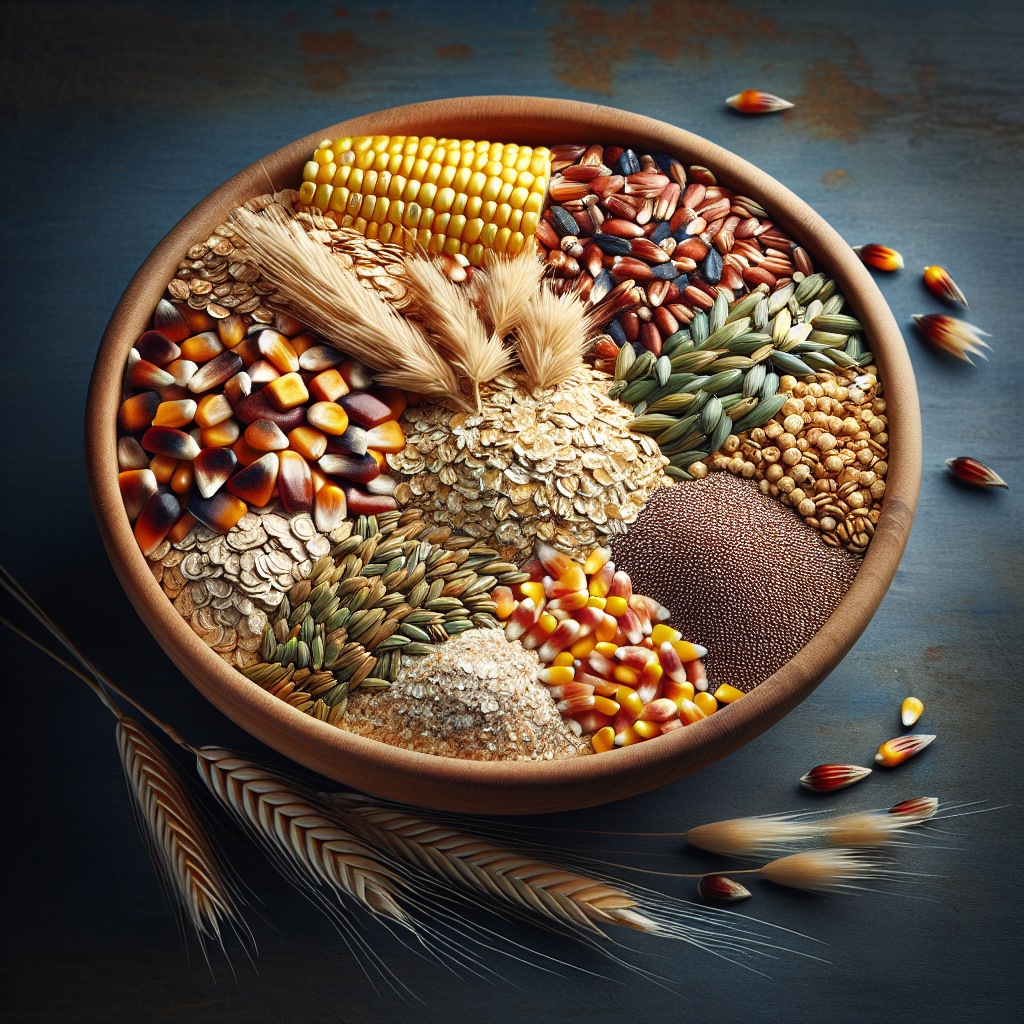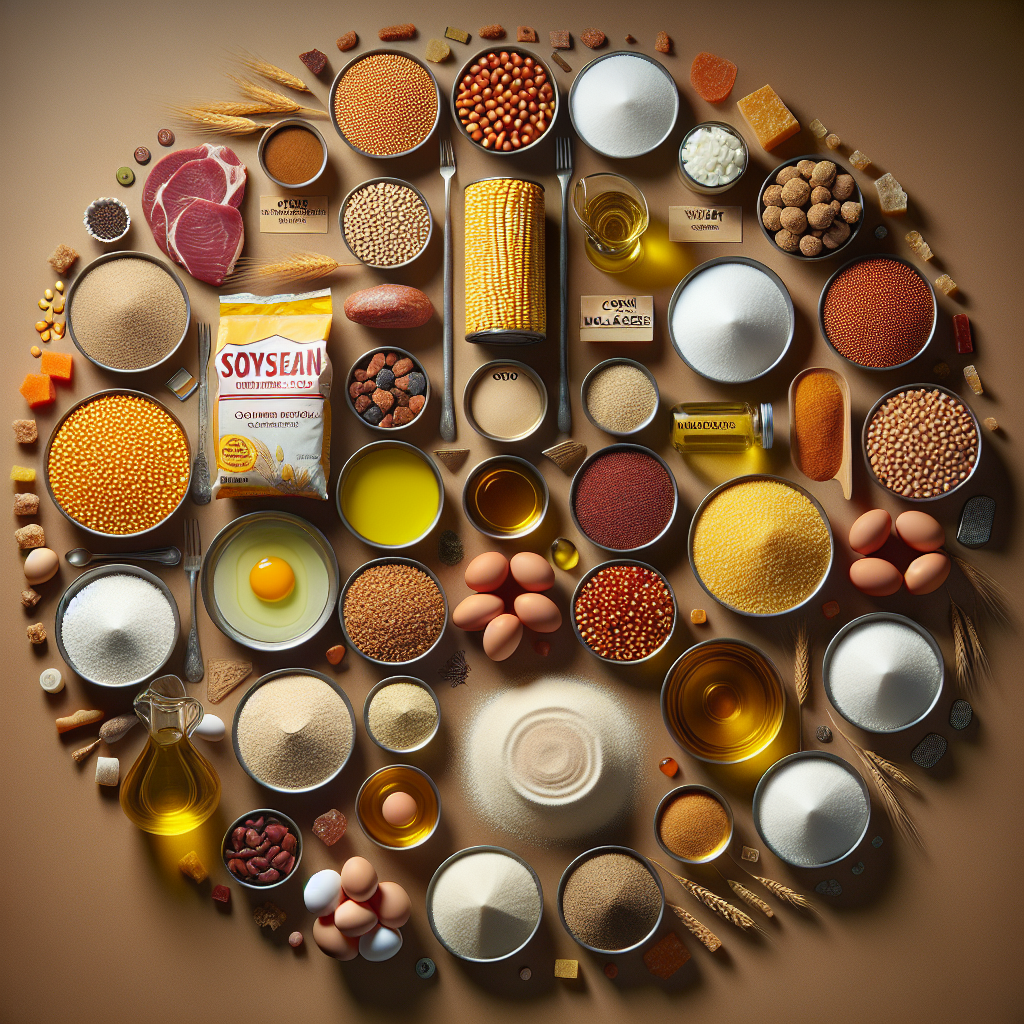In the world of chicken farming, the importance of a diverse ingredient composition in chicken feed cannot be overstated. By providing a wide range of nutrients, vitamins, and minerals, a diverse feed composition ensures that chickens are not only well-nourished, but also maintain optimal health. This article explores the various benefits that arise from diversifying chicken feed, from improved growth and development to enhanced disease resistance. So, grab a seat and discover the crucial role that diverse feed plays in raising healthy and productive chickens.
Maintaining Nutritional Balance
Ensuring that chickens receive a balanced and nutritious diet is essential for their overall health and well-being. A diverse ingredient composition in chicken feed is crucial to provide the necessary essential nutrients that chickens need to thrive. These nutrients include vitamins, minerals, proteins, fats, and carbohydrates. By incorporating a variety of ingredients into their feed, you can help meet these nutritional needs and promote optimal growth and development in your flock.
Providing Essential Nutrients
A diverse ingredient composition in chicken feed allows for a wide range of essential nutrients to be included. Essential nutrients are those that the chicken’s body cannot produce on its own and must be obtained from their diet. These nutrients play crucial roles in various bodily functions such as metabolism, immune function, and bone development. By providing a variety of ingredients, you can ensure that your chickens receive all the necessary vitamins, minerals, and amino acids that are essential for their health and growth.
Balancing Macronutrients
Macronutrients are nutrients that are needed in larger quantities and provide energy to the chickens. These include proteins, fats, and carbohydrates. Each macronutrient serves a specific purpose in the chicken’s diet. Proteins are essential for muscle development and repair, fats provide energy and aid in nutrient absorption, and carbohydrates are a vital source of energy. A diverse ingredient composition allows for a balanced ratio of these macronutrients, ensuring that the chickens receive the right amount of each for optimal health and growth.
Including Micronutrients
Micronutrients are essential for various physiological processes in chickens, even though they are needed in smaller quantities compared to macronutrients. These include vitamins and minerals, such as vitamin A, vitamin D, calcium, and phosphorus. These micronutrients play critical roles in bone development, immune function, and overall health. By incorporating a diverse range of ingredients in the chicken feed, you can ensure that these micronutrients are provided in adequate amounts, helping to support the chickens’ overall well-being.
Meeting Specific Dietary Needs
Different breeds of chickens and different stages of life have specific dietary needs. For example, laying hens require higher levels of calcium to support egg production, while broilers have different nutritional requirements to promote rapid growth. A diverse ingredient composition in chicken feed allows for customization and flexibility to meet these specific dietary needs. By formulating feeds with the appropriate combination of ingredients, you can ensure that each chicken receives the nutrients they need at every stage of their life cycle.
Improving Feed Conversion Efficiency
Feed conversion efficiency refers to how efficiently chickens convert the feed they consume into growth or egg production. Improving feed conversion efficiency is not only beneficial for the poultry industry but also has environmental implications. A diverse ingredient composition in chicken feed can help enhance feed conversion efficiency and reduce waste, resulting in more sustainable poultry production.
Enhancing Digestibility
A diverse ingredient composition in chicken feed can enhance digestibility, allowing for better utilization of the nutrients present in the feed. Different ingredients can provide a range of digestible proteins, fats, and carbohydrates that are easily broken down and absorbed by the chickens’ digestive system. By maximizing the digestibility of the feed, you can ensure that the chickens are obtaining the maximum nutritional value from their diet, promoting better growth and overall health.
Increasing Energy Utilization
Efficient energy utilization is crucial for growth and production in chickens. By including a diverse range of energy sources in chicken feed, such as grains and oils, you can provide a variety of forms of energy that can be readily utilized by the chickens’ bodies. This allows for optimal energy utilization and improved feed conversion efficiency, as the chickens can efficiently convert the energy obtained from the feed into productive activities like growth and egg production.
Reducing Feed Wastage
Minimizing feed wastage is not only cost-effective but also reduces the environmental impact of poultry production. A diverse ingredient composition in chicken feed can help reduce feed wastage by ensuring that chickens are receiving a balanced and palatable diet that meets their nutritional needs. When the feed is optimized with a variety of ingredients, it becomes more appetizing to the chickens, reducing the likelihood of selective feeding and feed wastage. Additionally, a diverse feed composition can help prevent boredom and encourage a healthy appetite, further reducing the amount of feed that goes to waste.
Ensuring Optimal Growth and Development
To ensure that chickens grow and develop to their full potential, it is crucial to provide them with the necessary nutrients. A diverse ingredient composition in chicken feed plays a significant role in supporting optimal growth, muscle development, bone health, and immune function.
Supporting Muscle Development
Proteins are the building blocks of muscle development, and providing high-quality proteins in the chicken feed is essential for supporting muscle growth. A diverse ingredient composition allows for the inclusion of different protein sources, such as soybean meal, fishmeal, and poultry by-products, which provide a wide range of essential amino acids necessary for muscle development. By incorporating these diverse protein sources, you can ensure that the chickens receive a balanced amino acid profile, promoting optimal muscle growth and development.
Promoting Bone Health
Calcium and phosphorus are essential minerals for bone development and eggshell production in laying hens. By including diverse sources of these minerals, such as oyster shells, limestone, and bone meal, in the chicken feed, you can support strong bone development and prevent deficiencies or skeletal abnormalities. Providing a diverse ingredient composition that includes these minerals in the appropriate ratios is crucial for promoting optimal bone health in chickens.
Boosting Immune Function
A strong immune system is essential for chickens to resist diseases and maintain overall health. A diverse ingredient composition in chicken feed can help boost the chickens’ immune function by including ingredients that provide essential vitamins and minerals, such as vitamin E, vitamin C, and selenium. These nutrients play vital roles in supporting the immune system and protecting chickens from infections and diseases. By providing a diverse range of ingredients that contain these immune-boosting nutrients, you can contribute to the overall well-being of your flock.
Enhancing Product Quality
The quality of poultry products, such as meat and eggs, is influenced by the feed given to the chickens. A diverse ingredient composition in chicken feed can help enhance the flavor, texture, and nutritional value of these products, resulting in higher quality poultry produce.
Improving Meat Flavor
The flavor of chicken meat is influenced by various factors, including the diet of the chickens. By incorporating diverse ingredients in the chicken feed, you can enhance the flavor of the meat through the different flavors and compounds present in the feed ingredients. For example, including herbs and spices in the feed can impart unique flavors to the meat, resulting in more flavorful and palatable poultry products for consumers.
Enhancing Meat Texture
The texture of chicken meat is another crucial aspect of product quality. A diverse ingredient composition in chicken feed can help improve the meat texture by providing a balanced ratio of proteins and fats. Different sources of proteins and fats, such as soybean meal and vegetable oils, contribute to a more tender and succulent meat texture. By ensuring a diverse feed composition, you can help achieve the desired texture and mouthfeel of the meat, enhancing the overall eating experience for consumers.
Increasing Egg Nutritional Value
The nutritional value of eggs is influenced by the diet of the laying hens. A diverse ingredient composition in the chicken feed can enhance the nutritional value of eggs by providing a wider range of essential nutrients. For example, incorporating omega-3-rich ingredients like flaxseed or fish oil can increase the omega-3 fatty acid content in the eggs, providing additional health benefits to consumers. By formulating a diverse feed that includes various nutrient-dense ingredients, you can offer eggs with higher nutritional value, appealing to health-conscious consumers.
Supporting Gut Health
Maintaining a healthy gut is vital for the overall well-being of chickens. A diverse ingredient composition in chicken feed can help support gut health by improving digestive function, enhancing gut microbiota, and reducing the risk of diseases.
Improving Digestive Function
A well-functioning digestive system is essential for chickens to properly utilize the nutrients from their feed. Including a diverse range of ingredients in the chicken feed can promote digestive function by providing dietary fibers and enzymes. Dietary fibers promote intestinal motility and help prevent digestive disorders like impacted crop or sour crop. Enzymes, such as amylase and protease, aid in the breakdown of complex carbohydrates and proteins, improving nutrient absorption. By ensuring a diverse ingredient composition, you can help support optimal digestive function in chickens.
Enhancing Gut Microbiota
The gut microbiota plays a crucial role in nutrient absorption, immune function, and overall health in chickens. A diverse ingredient composition in chicken feed can promote a healthy and diverse gut microbiota by providing prebiotics and probiotics. Prebiotics are indigestible fibers that serve as food for beneficial gut bacteria, while probiotics are live bacteria that confer health benefits when consumed. By including a variety of ingredients that contain prebiotic fibers and probiotics, you can help enhance the diversity and abundance of beneficial bacteria in the gut, supporting optimal gut health in chickens.
Reducing the Risk of Diseases
Maintaining a healthy gut is crucial for reducing the risk of gastrointestinal diseases in chickens. A diverse ingredient composition in chicken feed can contribute to reducing the risk of diseases by including ingredients with natural antimicrobial properties, such as oregano or garlic. These ingredients can help inhibit the growth of harmful bacteria in the gut, reducing the likelihood of infections and diseases. By incorporating diverse ingredients with natural antimicrobial properties, you can help support a healthy gut environment and minimize the risk of gastrointestinal diseases in your flock.
Reducing Environmental Impact
Sustainable poultry production involves minimizing the environmental impact associated with chicken farming. A diverse ingredient composition in chicken feed can help reduce nutrient excretion, lower greenhouse gas emissions, and diminish water pollution, contributing to a more environmentally friendly approach to poultry farming.
Minimizing Nutrient Excretion
Nutrient excretion from chicken farming can lead to pollution of soil and water bodies if not managed properly. A diverse ingredient composition in chicken feed can help minimize nutrient excretion by optimizing the ratios of nutrients in the feed. By providing balanced nutrition and avoiding over-supplementation of certain nutrients, you can help reduce the excess nutrients excreted by chickens, minimizing the environmental impact of poultry farming.
Lowering Greenhouse Gas Emissions
Greenhouse gas emissions from poultry farming, particularly from enteric fermentation and manure management, contribute to climate change. A diverse ingredient composition in chicken feed can help lower greenhouse gas emissions by utilizing ingredients that produce fewer emissions during production and digestion. For example, incorporating alternative protein sources like insects or algae can reduce the carbon footprint associated with feed production. By sourcing and formulating a diverse feed composition that takes into account the environmental impact of the ingredients used, you can contribute to reducing greenhouse gas emissions from poultry farming.
Diminishing Water Pollution
Poor management of chicken manure can result in water pollution, as the nutrients from the manure can runoff into nearby water sources. A diverse ingredient composition in chicken feed can help diminish water pollution by reducing excess nutrients excreted by chickens. By providing balanced nutrition and avoiding over-supplementation, you can minimize the nutrient content in the manure, reducing the risk of nutrient runoff and water pollution. Additionally, utilizing plant-based protein sources and incorporating ingredients like phytase can help improve nutrient utilization and reduce the phosphorus content in the manure, further reducing the environmental impact.
Ensuring Animal Welfare
Providing a diverse ingredient composition in chicken feed is not only crucial for the chickens’ health but also for their overall welfare. A balanced and nutritious diet contributes to preventing nutritional deficiencies, enhancing palatability, and avoiding the unnecessary use of antibiotics.
Preventing Nutritional Deficiencies
A diverse ingredient composition in chicken feed is key to preventing nutritional deficiencies in chickens. Balanced nutrition is essential for their growth, development, and overall health. By incorporating a wide range of ingredients, you can ensure that the chickens receive all the necessary vitamins, minerals, and other essential nutrients they need to thrive. Preventing nutritional deficiencies not only supports their overall health but also ensures that they have the necessary energy and resources to exhibit natural behaviors and cope with environmental stressors.
Enhancing Palatability
Palatability refers to the taste, smell, and overall appeal of the feed to the chickens. A diverse ingredient composition in chicken feed can enhance palatability by providing a variety of flavors and textures. Incorporating different ingredients like grains, seeds, and herbs can add diversity and create a more enticing feed for the chickens. When the feed is palatable, the chickens are more likely to consume an adequate amount, ensuring that they receive the necessary nutrients for their well-being.
Avoiding Antibiotic Use
The unnecessary use of antibiotics in animal farming contributes to the development of antibiotic resistance, which poses a significant threat to public health. A diverse ingredient composition in chicken feed can help avoid the need for routine antibiotic use by promoting a healthy immune system and preventing disease outbreaks. By providing a balanced and nutrient-rich diet, you can support the chickens’ immune function, making them less susceptible to infections and reducing the need for antibiotics. Additionally, incorporating ingredients with natural antimicrobial properties can further support disease prevention and reduce the reliance on antibiotics.
Mitigating Health and Disease Risks
Mitigating health and disease risks is crucial for ensuring the well-being of chickens and preventing economic losses in poultry farming. A diverse ingredient composition in chicken feed can help avoid contaminant accumulation, prevent outbreaks of avian diseases, and reduce antibiotic resistance.
Avoiding Contaminant Accumulation
Contaminant accumulation in chicken products can pose risks to human health. A diverse ingredient composition in chicken feed can help avoid contaminant accumulation by sourcing ingredients from reputable suppliers and implementing strict quality control measures. By ensuring the safety and quality of the ingredients used in the feed, you can minimize the risk of contaminants, such as pesticides or heavy metals, entering the food chain through poultry products.
Preventing Outbreaks of Avian Diseases
Outbreaks of avian diseases can have devastating consequences for the poultry industry and pose risks to animal and human health. A diverse ingredient composition in chicken feed can help prevent outbreaks of avian diseases by ensuring optimal immune function and promoting overall health in chickens. By providing a balanced and nutrient-rich diet, you can support the chickens’ immune system, making them better able to resist infections and reducing the likelihood of disease outbreaks.
Reducing Antibiotic Resistance
The overuse and misuse of antibiotics in animal farming contribute to the development of antibiotic resistance, a global health concern. A diverse ingredient composition in chicken feed can help reduce antibiotic resistance by promoting a healthy gut microbiota and avoiding unnecessary antibiotic use. By incorporating prebiotics and probiotics into the feed, you can support a diverse and beneficial gut microbiota, which plays a crucial role in preventing the growth of antibiotic-resistant bacteria. Additionally, by implementing responsible antibiotic stewardship practices and only using antibiotics when necessary, you can help minimize the development of antibiotic resistance.
Promoting Sustainable Agriculture
Promoting sustainable agriculture is essential for the long-term viability of the poultry industry and environmental conservation. By incorporating a diverse ingredient composition in chicken feed, you can contribute to preserving biodiversity, using locally sourced ingredients, and reducing dependence on imported feed.
Preserving Biodiversity
Biodiversity refers to the variety of living organisms on Earth and the ecosystems they inhabit. A diverse ingredient composition in chicken feed can help promote biodiversity by utilizing a wide range of plant-based ingredients sourced from different regions and ecosystems. By supporting biodiversity in feed production, you are indirectly contributing to environmental conservation and the preservation of ecosystems that are crucial for maintaining a healthy planet.
Using Locally Sourced Ingredients
Using locally sourced ingredients in chicken feed can have several benefits. Firstly, it reduces the carbon footprint associated with transportation and supports local farmers and businesses. Secondly, it promotes food security by reducing reliance on imported feed ingredients, which can be affected by supply chain disruptions or price fluctuations. By incorporating locally sourced ingredients, you can contribute to a more sustainable and resilient poultry industry.
Reducing Dependence on Imported Feed
Dependence on imported feed ingredients can make the poultry industry vulnerable to price fluctuations and supply chain disruptions. A diverse ingredient composition in chicken feed can help reduce dependence on imported feed by incorporating alternative protein sources and utilizing locally available ingredients. By diversifying the feed composition and sourcing ingredients from different suppliers, you can enhance the resilience of the poultry industry and reduce its environmental impact.
Complying with Regulatory Standards
Compliance with regulatory standards is essential for ensuring food safety, protecting the environment, and maintaining consumer trust. A diverse ingredient composition in chicken feed can help meet nutritional guidelines, adhere to food safety regulations, and follow environmental regulations.
Meeting Nutritional Guidelines
Nutritional guidelines for poultry feeds are established to ensure that the chickens receive the necessary nutrients for their health and growth. A diverse ingredient composition in chicken feed can help meet these nutritional guidelines by providing a balanced and nutrient-rich diet. By formulating feeds with a wide range of ingredients in appropriate ratios, you can ensure that the feed complies with the established nutritional standards and supports the well-being of your flock.
Adhering to Food Safety Regulations
Food safety regulations aim to protect consumers from foodborne illnesses and ensure the safety and quality of poultry products. A diverse ingredient composition in chicken feed can contribute to meeting food safety regulations by sourcing ingredients from reputable suppliers and implementing strict quality control measures. By ensuring the safety and quality of the ingredients used in the feed, you can minimize the risks of contamination and promote the production of safe and wholesome poultry products.
Following Environmental Regulations
Environmental regulations govern various aspects of poultry farming to minimize its impact on the environment. A diverse ingredient composition in chicken feed can help comply with these regulations by reducing nutrient excretion, lowering greenhouse gas emissions, and minimizing water pollution. By incorporating sustainable practices and utilizing diverse feed ingredients, you can contribute to reducing the environmental footprint of poultry farming and ensure compliance with environmental regulations.
In conclusion, a diverse ingredient composition in chicken feed is crucial for maintaining nutritional balance, improving feed conversion efficiency, supporting optimal growth and development, enhancing product quality, promoting gut health, reducing environmental impact, ensuring animal welfare, mitigating health and disease risks, promoting sustainable agriculture, and complying with regulatory standards. By incorporating a wide range of ingredients in the chicken feed, you can provide the necessary nutrients, optimize feed utilization, support the chickens’ overall well-being, and contribute to a more sustainable poultry industry.




